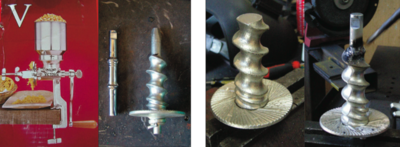Moulin à pédales pour moudre les graines et le café : Différence entre versions
| Ligne 1 : | Ligne 1 : | ||
Traduction en cours... | Traduction en cours... | ||
| + | {{stub}} | ||
| + | [[Category:English Review]] | ||
| + | |||
| + | ==Description courte== | ||
| + | *'''Problème:''' manque d'électricité ou manque de broyeur électrique | ||
| + | *'''Idée:''' combinez une bicyclette et un moulin à main dans un moulin à pédales | ||
| + | *'''Material Needed:''' bicyclette, barres métalliques, bois, moulin à main, dispositif de soudage | ||
| + | |||
| + | |||
| + | ==Concept== | ||
| + | [[File: Pedal_mill.png|350px|Pedal Mill]]<br> | ||
| + | La machine est facile à utiliser, facile à entretenir et raisonnablement portable. Elle peut être utilisée n'importe où par n'importe qui. Il est également simple de passer du dégrainage au fraisage en dévissant un appareil et en fixant l'autre. La fonction Mill a la capacité de moudre 3 lb. par minute pour tout type de grains ou grains de café. L'utilisation la plus courante consiste à broyer du maïs jaune, des haricots de soja et d'autres éléments qui constituent l'alimentation animale. The Corn Degrainer, par exemple, est utilisé après la récolte et dégrains facilement 1200 à 1500 livres par jour. | ||
| + | |||
| + | ==Comment construire un moulin== | ||
| + | |||
| + | '''Le moulin'''<br> | ||
| + | [[File: Pedal_mill_1.png|400px|Pedal mill]]<br> | ||
| + | |||
| + | Retirez la broche centrale. Une extrémité comprend la poignée, l'autre extrémité fait partie du mécanisme de meulage. La partie de la poignée est coupée complètement et une partie d'un axe de manivelle 'fissuré' * est soudé à son endroit. Il doit être carré. Nous utilisons des électrodes conçues pour l'acier moulé pour souder cette pièce. Le moulin finira par se fixer sur le cadre.<br> | ||
| + | [[File: Pedal_mill_2.png|400px|Ajustement du moulin]]<br> | ||
| + | Retirez le support de table comme indiqué, en laissant un bord plat. Notre axe adapté a besoin d'une cale de tuyau. Insérez un si nécessaire et reculez tout excès. Il est maintenant prêt à accepter un pignon denté avec sa manivelle enlevée. Une batteuse de maïs peut être adaptée de manière similaire.<br> | ||
| + | [[File: Pedal_mill_3.png|200px|The interchangeable thresher and the degrainer adapted to pedal power]]<br> | ||
| + | |||
| + | '''Le chassis'''<br> | ||
| + | [[File: Pedal_mill_4.png|190px|How to make the 90� corners for the seat support.]] | ||
| + | [[File: Pedal_mill_5.png|400px|Bike frame alligned and how you can form a better bond for the chassis' welding.]]<br> | ||
| + | The bike frame is cut as above. The frame shown in the pictures has a 450mm eat tube, 250mm down tube. The full length of chain stays. <br> | ||
| + | Form the 90 degree corners as shown, cutting, folding and welding the angle iron. Weld the bike frame in place, lining up the sprockets so the chain will run straight. You will need to bend the drive-side chain stay in order to clear the chain. To form a better bond, the frame is flattened and bent before welding it to the chassis. File any sharp edges and paint. | ||
| + | [[File: Pedal_mill_6.png|200px|Pedal mill]]<br> | ||
| + | |||
| + | '''The Flywheel'''<br> | ||
| + | [[File: Pedal_mill_7.png|200px|welded and rebuilt hub]]<br> | ||
| + | The Flywheel shown in the picture is made from a 20� wheel. Both ends of the hub must be threaded to accept sprockets. This can be achieved either by cutting and welding the threaded end from another hub, or by replacing one side of the hub and rebuilding the wheel. The welding option is easier but prone to causing undesirable wobble in the casette. The split image above shows the two options: Above is welded, below is a rebuilt hub. The hub is a push fit construction so it is possible to prise off the redundant unthreaded piece and tap on a threaded one from an identical hub. Fit spokes using a screwdriver, rather than a spoke tensioner for speed.<br> | ||
| + | [[File: Pedal_mill_8.png|400px|flywheel]]<br> | ||
| + | The mould for the concrete is made using a childs bike wheel cover. These are hard to come by, so you may need to improvise. It is kept in place with a cassette and packed with newspaper to prevent leakage. Mix the cement with two parts sand. Place the wheels on a bucket to provide support. Once filled and smoothed over, place in the shade to dry overnight.<br> | ||
| + | [[File: Pedal_mill_9.png|400px|finished flywheel]]<br> | ||
| + | The concrete is painted to protect from moisture. One side accepts a multi speed cassette, the other a single speed sprocket. The axel position will need to be adjusted accordingly.<br> | ||
| + | |||
| + | '''The Seat'''<br> | ||
| + | [[File: Pedal_mill_10.png|400px|seat]]<br> | ||
| + | The seat shown in the picture is recycled plywood. The support is made from thin box section steel. There is a simple bracket in order to make the seat position adjustable. The nut is welded in place for easy tightening. The seat can then be painted. <br> | ||
| + | |||
| + | '''The Handlebars'''<br> | ||
| + | [[File: Pedal_mill_11.png|400px|handlebars]]<br> | ||
| + | We use steel dropped racer bars. Cut them in half. In order to bolt on the hangle bars, you can weld 8mm bolts onto 20mm washers.<br> | ||
| + | |||
| + | '''The Chain Assembles'''<br> | ||
| + | [[File: Pedal_mill_12.png|400px|chain assembles]]<br><br> | ||
| + | [[File: Pedal_mill_13.png|400px|chain assembles]]<br> | ||
| + | These are then welded onto to cut ends of the handlebar and filed smooth. They are then ready to be bolted onto the chassis. The drive side derailleur is bolted in place as it would be on the bike. However it will need to be filed to fit flush with the frame. We use the old style of derailleur that bolts onto the axel rather than the bike frame. Now you can add a gear shifter. A simple friction type is best than an index shifter. Use the adjustment screws on the derailleur to make sure it selects all gears without the chain coming off. | ||
| + | Now you can add the 2nd derailleur and the grinder. This derailleur is upside down and its position is fixed. Adjustments are made using the screws. | ||
| + | Attach the grinder with clamps to locate its position before drilling the frame and bolting. Aim to have the chain run as straight as possible.<br> | ||
| + | |||
| + | ==Exemple de réussite== | ||
| + | Guatemala | ||
| + | |||
| + | ==Références et autre lecture== | ||
| + | * Carlos Marroquin, Henry Godfrey, Maya Pedal 2010, http://www.mayapedal.org/ | ||
| + | |||
| + | |||
| + | ==Articles connexes== | ||
| + | - [[Principles of Muscle Power]] <br> | ||
| + | - [[Treadmills]] <br> | ||
| + | - [[Pedal-Powered Devices (Overview)]] <br> | ||
| + | - [[Pedal-Powered Electricity Generator]] <br> | ||
| + | - [[Pedal-Powered Blender]] <br> | ||
| + | - [[Hand-Crank Devices (Overview)]] <br> | ||
| + | - [[Hand-Crank Electricity Generator]] <br> | ||
| + | - [[Hand-Crank Blender]] <br> | ||
| + | - [[Hand-Crank Food/Grain/Coffee Mill]] <br> | ||
| + | |||
| + | ==Catégories== | ||
| + | |||
| + | [[en:Pedal-Powered Food/Grain/Coffee Mill]] | ||
| + | |||
[[en: Pedal-Powered Food/Grain/Coffee Mill]] | [[en: Pedal-Powered Food/Grain/Coffee Mill]] | ||
Version du 25 avril 2017 à 16:52
Traduction en cours...
Sommaire
Description courte
- Problème: manque d'électricité ou manque de broyeur électrique
- Idée: combinez une bicyclette et un moulin à main dans un moulin à pédales
- Material Needed: bicyclette, barres métalliques, bois, moulin à main, dispositif de soudage
Concept
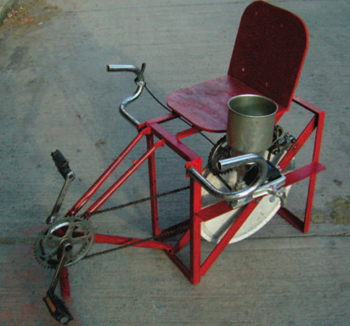
La machine est facile à utiliser, facile à entretenir et raisonnablement portable. Elle peut être utilisée n'importe où par n'importe qui. Il est également simple de passer du dégrainage au fraisage en dévissant un appareil et en fixant l'autre. La fonction Mill a la capacité de moudre 3 lb. par minute pour tout type de grains ou grains de café. L'utilisation la plus courante consiste à broyer du maïs jaune, des haricots de soja et d'autres éléments qui constituent l'alimentation animale. The Corn Degrainer, par exemple, est utilisé après la récolte et dégrains facilement 1200 à 1500 livres par jour.
Comment construire un moulin
Retirez la broche centrale. Une extrémité comprend la poignée, l'autre extrémité fait partie du mécanisme de meulage. La partie de la poignée est coupée complètement et une partie d'un axe de manivelle 'fissuré' * est soudé à son endroit. Il doit être carré. Nous utilisons des électrodes conçues pour l'acier moulé pour souder cette pièce. Le moulin finira par se fixer sur le cadre.
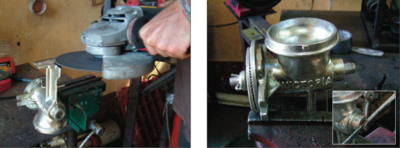
Retirez le support de table comme indiqué, en laissant un bord plat. Notre axe adapté a besoin d'une cale de tuyau. Insérez un si nécessaire et reculez tout excès. Il est maintenant prêt à accepter un pignon denté avec sa manivelle enlevée. Une batteuse de maïs peut être adaptée de manière similaire.
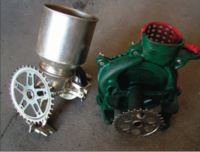
Le chassis
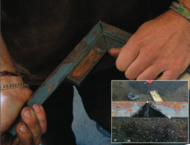
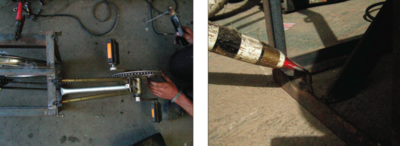
The bike frame is cut as above. The frame shown in the pictures has a 450mm eat tube, 250mm down tube. The full length of chain stays.
Form the 90 degree corners as shown, cutting, folding and welding the angle iron. Weld the bike frame in place, lining up the sprockets so the chain will run straight. You will need to bend the drive-side chain stay in order to clear the chain. To form a better bond, the frame is flattened and bent before welding it to the chassis. File any sharp edges and paint.
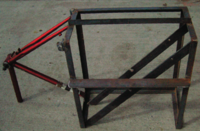
The Flywheel
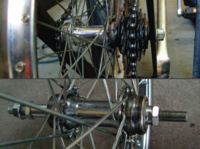
The Flywheel shown in the picture is made from a 20� wheel. Both ends of the hub must be threaded to accept sprockets. This can be achieved either by cutting and welding the threaded end from another hub, or by replacing one side of the hub and rebuilding the wheel. The welding option is easier but prone to causing undesirable wobble in the casette. The split image above shows the two options: Above is welded, below is a rebuilt hub. The hub is a push fit construction so it is possible to prise off the redundant unthreaded piece and tap on a threaded one from an identical hub. Fit spokes using a screwdriver, rather than a spoke tensioner for speed.
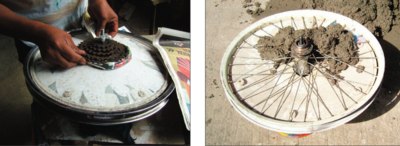
The mould for the concrete is made using a childs bike wheel cover. These are hard to come by, so you may need to improvise. It is kept in place with a cassette and packed with newspaper to prevent leakage. Mix the cement with two parts sand. Place the wheels on a bucket to provide support. Once filled and smoothed over, place in the shade to dry overnight.
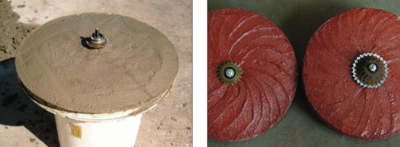
The concrete is painted to protect from moisture. One side accepts a multi speed cassette, the other a single speed sprocket. The axel position will need to be adjusted accordingly.
The Seat
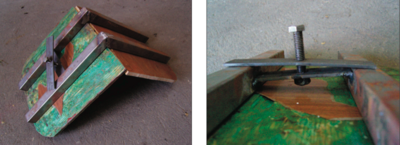
The seat shown in the picture is recycled plywood. The support is made from thin box section steel. There is a simple bracket in order to make the seat position adjustable. The nut is welded in place for easy tightening. The seat can then be painted.
The Handlebars
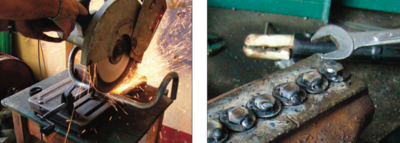
We use steel dropped racer bars. Cut them in half. In order to bolt on the hangle bars, you can weld 8mm bolts onto 20mm washers.
The Chain Assembles
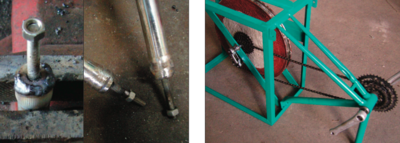
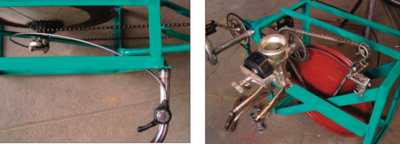
These are then welded onto to cut ends of the handlebar and filed smooth. They are then ready to be bolted onto the chassis. The drive side derailleur is bolted in place as it would be on the bike. However it will need to be filed to fit flush with the frame. We use the old style of derailleur that bolts onto the axel rather than the bike frame. Now you can add a gear shifter. A simple friction type is best than an index shifter. Use the adjustment screws on the derailleur to make sure it selects all gears without the chain coming off.
Now you can add the 2nd derailleur and the grinder. This derailleur is upside down and its position is fixed. Adjustments are made using the screws.
Attach the grinder with clamps to locate its position before drilling the frame and bolting. Aim to have the chain run as straight as possible.
Exemple de réussite
Guatemala
Références et autre lecture
- Carlos Marroquin, Henry Godfrey, Maya Pedal 2010, http://www.mayapedal.org/
Articles connexes
- Principles of Muscle Power
- Treadmills
- Pedal-Powered Devices (Overview)
- Pedal-Powered Electricity Generator
- Pedal-Powered Blender
- Hand-Crank Devices (Overview)
- Hand-Crank Electricity Generator
- Hand-Crank Blender
- Hand-Crank Food/Grain/Coffee Mill
